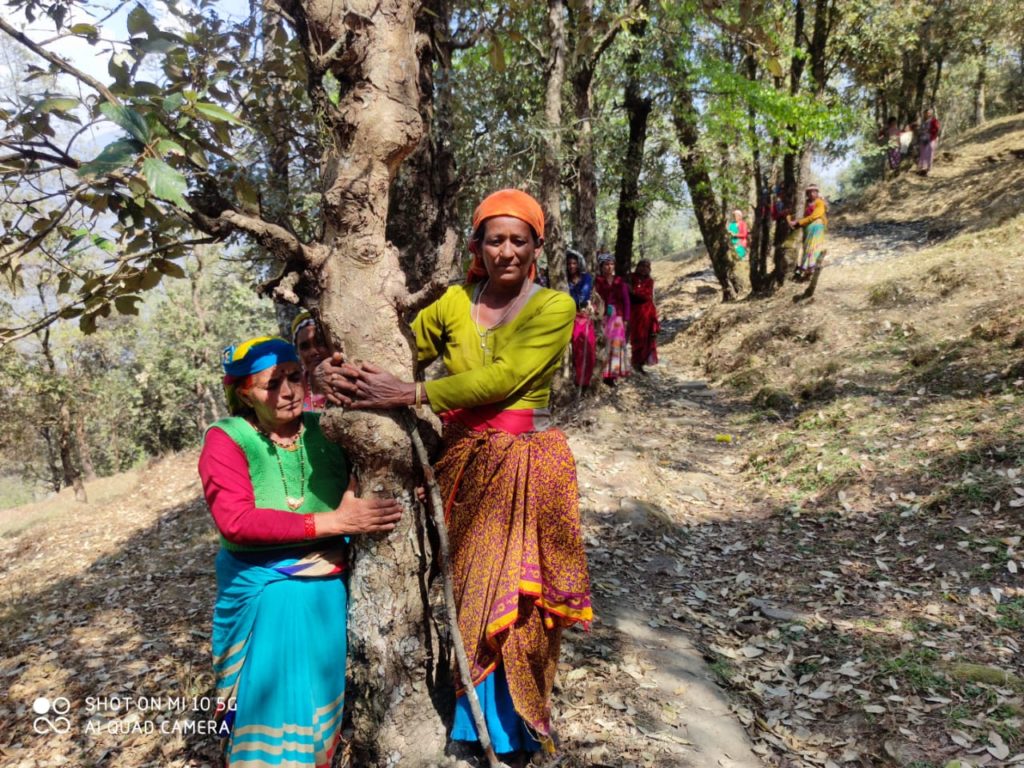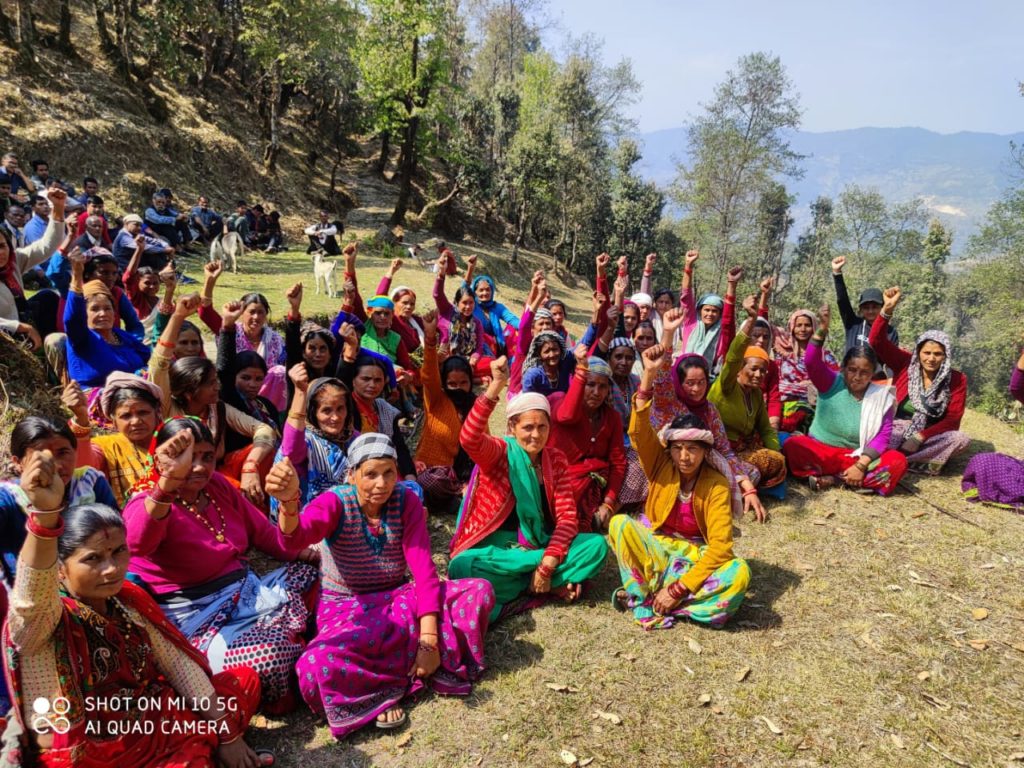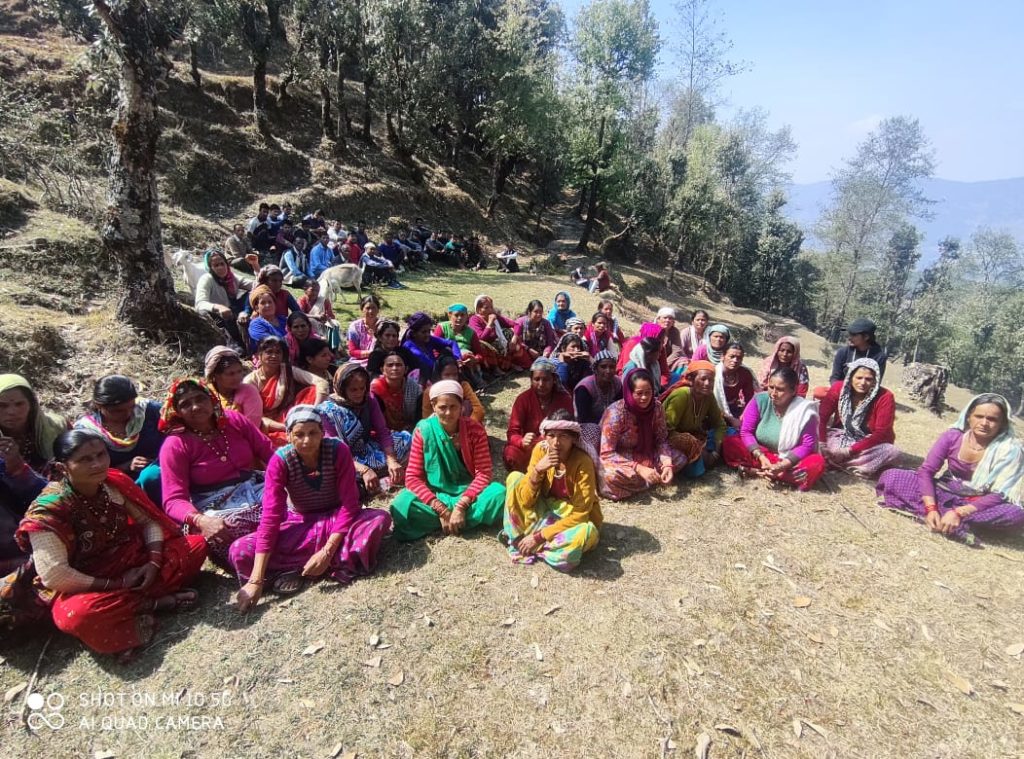Uttarakhand villagers launch another Chipko Andolan to protect their sacred grove
For the past five days, villagers in Bageshwar district of Uttarakhand are protesting against the proposed felling of trees for a road project. They have launched the 'Chipko of Bageshwar' movement to save their trees.

Dehradun, Uttarakhand
Since March 15, women of Jakhni village in Bageshwar district of Uttarakhand are hugging trees and sitting on a protest against a proposed two-kilometre long road to Majgaon village. Villagers fear the project will lead to the chopping down of around 500 oak trees, which they have nurtured with great care. The forest cover in the area also ensures recharge of groundwater and keeps the springs alive, claim the protesting residents. They have termed this protest as the “Chipko of Bageshwar”.
“We are aware how the forests have helped recharge our water bodies, the naulas,” Kalawati Devi, a resident and part of the new Chipko movement, told Gaon Connection. Laksmi Mehta, another villager said while hugging the tree that she will not back off until justice is served and the orders (for felling of the trees) are withdrawn.
Ishwar Singh, gram pradhan (village head) of Jakhni informed Gaon Connection that around 100 women hugged trees to save the sacred grove (forest dedicated to deity).
After the recent Chamoli disaster, villagers in Bageshwar are worried that cutting their forests for road construction may destroy springs and invite more landslides. However, the forest department claims only 43 trees will be axed for the proposed road project.

Sacred grove of Kotagiri Devi
The residents of Jakhni have been conserving and protecting their forests since late 1970s. The famous Chipko Andolan was launched from the state in 1973 when rural women hugged trees to protect them. This was also the beginning of environmental movement in the country.
In 1978, villagers of Jakhni embarked on a journey to dedicate the green patches, forests and green belts to the local deities. “The practice helped in revival of green cover in the district. As of now close to 6,000 hectares of green cover or forests belong to Kotagiri Devi, the Goddess of Justice in the hills of Uttarakhand,” Kamla Devi, sarpanch of Jakhni who is leading the “Chipko of Bageshwar” movement, told Gaon Connection.
According to the villagers, under this arrangement of protecting forests as sacred grove, the land is dedicated for a duration ranging between five to fifteen years. Villagers do not collect firewood from the forest, nor do they pluck leaves or take their cattle for grazing. Only the dried twigs are collected once a year after offering prayers to the deity.
The area where the road is proposed is thickly populated with Banjh Oak trees that play an important role in recharging local springs, maintaining adequate water levels, retaining soil moisture and preventing soil erosion, claim the protesting residents.

“Indiscriminate forest degradation for development activities like road widening has led to drying up of natural water springs in this area,” Hemwant Singh Mehta, a resident of Jakhni and president of the non-profit Jakhni Pariwar Foundation, told Gaon Connection.
The situation is such that all these villages face acute water shortage in summers but, this year even in winter months the area has been grappling with water issues, he said. This year because of low rainfall and less snowfall, the groundwater and local springs were not recharged.
Whereas thick forest cover ensures year-long access to water for over 600 villagers of Jakhni, just five kilometres away from it is the market town of Kamedi Devi, which is a cluster of about 200-300 villages, and faces acute water scarcity. These villages are being supplied from Sarayu river, about 43 kilometres in Bageshwar town. “Jakhni’s naula [community water source] maintains decent water supply. This is because the villagers have been saving their forests,” said Hemwant Singh.
Road to destruction
In May 2013, the Forest Department conducted a survey, in which the trees that obstructed the route of proposed road construction to village Majgaon were marked. According to the survey report, a total of 43 Banjh Oak trees of the girth 10-20 centimetres (cms) and above were marked for felling. “Of the total, 33 trees were marked in Jakhni and 10 in Majgaon… The villagers are counting saplings and other thin trees,” Balwant Singh Shahi, district forest officer of Bageshwar, told Gaon Connection.
“The road between Majgaon and Jakhni is under dispute because of a conflict among the residents of these two villages,” said Shahi. “The road is being laid because the residents of Majgaon demanded. They went to the high court and got the orders based on which the forest department obtained a No Objection Certificate,” he added.
However, Hemwant Singh argued that the road has already reached Majgaon. The road under construction is to connect Majgaon to Chaunala which is just 50 metres away from the site of protest, he said.
“A motorable road already connects Majgaon with the main road. Alternatively, there are two-three other roads that connect Chaunala to Majgaon. The proposed road will be detrimental to our sacred forests and this is why we are protesting,” he added.

We are also worried that due to cutting down of trees, landslides may become frequent, which will destroy springs, our only source of drinking water. “Only one natural spring is left which takes care of water needs of the people of Jakhni,” said Hemwant Singh.
Kalyan Singh Mehta, a retired health official from Jakhni added that the protest was not against development but against the threat it may impose on the environment. Eighty-year-old Dham Singh Mehta, former gram pradhan of Jakhni is also part of the ongoing protest. “This road is the way to destruction of water bodies,” he added.
Meanwhile, on March 18, on day four of the ongoing protest, PS Fartyal, assistant engineer, Public Works Department, Kapkote, Bageshwar, surveyed the area and concluded that since after two kilometres from the protest site, there is no human settlement, the work related to the disputed road should be stopped.
Also Read: Uttarakhand: The Himalayan state is besieged by extreme floods and increased droughts

